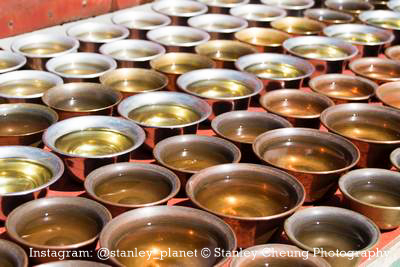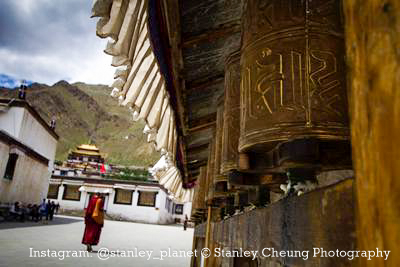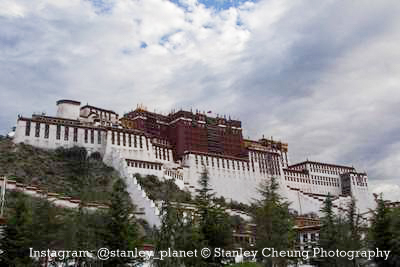Home > Destinations > Asia > Tibet > Attractions
TIBET ATTRACTIONS
Lhasa
Lhasa the capital city of Tibet at an altitude of 3,650 meters, is situated on the northern banks of the Kyichu River. Lhasa in Tibetan means "Palace of Gods", the residence of Dalai Lama (The God King), is the earthly representation of the Celestial Palace of Avaloketeswora, the Buddha of Infinite Compassion whose incarnation in the human form is believed to be Dalai Lama. As Tibet's political, religious and cultural center, it is a city truly blessed by the gods, where life is unhurried, and it's people are jovial.
Potala Palace
 This legendary palace built atop, a single hill is synonymous with Tibet. First built in the 7th century as a fortress by Tibet's foremost king, Srongtsen Gampo, it was later expanded to its present structure during the 17th century by the 5th Dalai Lama. This 13 story, 1000 room citadel served as the headquarters of the former 'church state' of Tibet and was home to the successive Dalai Lamas, who from the latter half of the 18th century used it as their winter palace.
This legendary palace built atop, a single hill is synonymous with Tibet. First built in the 7th century as a fortress by Tibet's foremost king, Srongtsen Gampo, it was later expanded to its present structure during the 17th century by the 5th Dalai Lama. This 13 story, 1000 room citadel served as the headquarters of the former 'church state' of Tibet and was home to the successive Dalai Lamas, who from the latter half of the 18th century used it as their winter palace.
The Norbu Linkha
The 'Jewel Park ' as it is known in Tibetan, was built in the 18th century and served as the Summer Palace of the Dalai Lamas. This colorful garden landscape was the site of picnic gathering. The palaces are richly decorated, creating an atmosphere of peaceful response.
The Jokhang Temple
Situated in the heart of Old Lhasa, it houses Tibet's most precious religious relics, a golden Shakyamuni Buddha which was brought as a gift by the Chinese Princess Wen Ching on the occasion of her wedding to the Tibetan King, Srongtsen Gampo. Surrounding the Jokhang Temple is the bustling Barkhor market place which is the religious and social focus of Lhasa.
Drepung Monastery
Said to be largest monastery in the world housing over 10,000 monks, it was founded in AD 1416 by the disciple of Tsonkhapa, founder of the Gelugpa Yellow Hat sect of Tibetan Buddhism. The Second, Third, and Fourth Dalai Lamas lived and were entombed here. Drepung in Tibetan means ' mound of rice'.
Gyantse
Gyantse is a pastoral town between Lhasa and Shigatse. It is 264 Kilometers south west of Lhasa and still retains the charm of a traditional Tibetan town untouched by modern expansion. It made world headlines in 1904 when Colonel Younghusband led a British Expedition to Tibet and defeated the Tibetan army there. As a cross road on the principal trade route to India, it was once renowned for the excellence of its carpets. The compound, encircled by an impressive wall once contained 19 monasteries presided over by the still fortress perched atop a nearby mountain.
Kumbum
This building in Gyantse is one of the most unique and magnificent in Tibet consisting of 6 Stories complete with a Buddhist Hall and a prayer hall. It has 112 chapels and its walls are adorned with religious paintings. Built in the 15th Century, it has since then withstood all the ravages of battles and revolutions.
Pelkhor Chode Monastery
Located next to Gyantse's Kumbum, it was founded in the 15th century. It has been remarkably well preserved and many of the statues and paintings inside date back to the time of its founding.
Shigatse
 Shigatse is the second largest city in Tibet and the capital of the Tsang province. It is 354 kilometers west of Lhasa at an altitude of 3180 meters.
Shigatse is the second largest city in Tibet and the capital of the Tsang province. It is 354 kilometers west of Lhasa at an altitude of 3180 meters.
Tashilhunpo Monastery
Founded in AD 1447 by Genden Drup, the First Dalai lama. It is the seat of the Panchen Lama who is second to the Dalai Lama in Tibetan Buddhist hierarchy. The 5th Dalai Lama declared that his teacher, then the Abbot of Tashilhunpo, was a manifestation of the Buddha Amitabha and the fourth in line of incarnate Lamas who would henceforth be referred to by the title of Panchen Rinpoche. Tashilhunpo has one of the world's largest statues, a 9 storied gilded bronze statue of Maitreya, the future Buddha.
Shalu Monastery
Shalu is 19 kilometers southwest of Shigatse. It was famous as a Tantric school where yogic practices were taught and perfected. The architecture outside, especially the roof, is uniquely Chinese.
Sakya Monastery
Sakya lies 143 kilometers to the southwest of Shigatse. Shaky Monastery, the center of the Sakya order of Tibetan Buddhism, was founded in 1073 by Konchok Gyalpo. During the rule of the Sakyapas, the priest/patron relationship between Tibet and China was established. Sakya rules reigned over Tibet for nearly a hundred years from the 13th to the 14th century. Many of its priceless images, statues, holy scriptures remaining today back to the time to its founding.
A Word of Warning
Tibet is one of the most remarkable places to visit in Asia. It offers fabulous monastery sights, taxing high-altitude treks, stunning views of the world's highest mountains and fabled pilgrimage routes. The stunning scenery, friendly hospitality and experience of the their religion are the ingredients for a unique and rewarding adventure. However, with the sometimes-frustrating nature of the country, you will need to exercise patience and approach things with a sense of humor. If you expect everything to run as planned, if you want a predictable and consistent quality in your accommodation and transport - DO NOT travel to Tibet! If you love adventure and want a completely unique travel experience, we guarantee your journey will be a rewarding and memorable experience.
|
|---|
Newsletter Subscription: 訂閱最新旅遊資訊
Site Map · Privacy Policy 私隱政策(只附英文版)
© 2020 Exotic-Holidays.hk · All Rights Reserved.
![]()


